An Integrated Analytical Approach to Define the Compositional and Textural Features of Mortars Used in the Underwater Archaeological Site of Castrum Novum (Santa Marinella, Rome, Italy)
Abstract
1. Introduction
2. Materials and Methods
3. Results and Discussion
3.1. Stereomicroscopy Observation
3.2. Thin-Section Petrography by Optical Microscopy (OM)
3.3. X-ray Powder Diffraction Analysis (XRPD)
3.4. Electron Probe Micro Analysis Equipped with Energy-Dispersive Spectroscopy (EPMA-EDS)
4. Conclusions
Author Contributions
Funding
Conflicts of Interest
References
- Ricci, S.; Davidde, B.; Bartolini, M.; Priori, G.F. Bioerosion of lapideous artefacts found in the underwater archaeological site of Baia (Naples). Archaeol. Marit. Mediterr. Int. J. Underw. Archaeol. 2009, 6, 167–186. [Google Scholar]
- La Russa, M.F.; Ruffolo, S.A.; Ricci, S.; Davidde, B.; Barca, D.; Ricca, M.; Capristo, V. A Multidisciplinary approach for the study of underwater artefacts: The case of TritoneBarbato marble statue (GrottaAzzurra, Island of Capri, Naples). Period. Miner. 2013, 82, 101–111. [Google Scholar]
- La Russa, M.F.; Ricca, M.; Belfiore, C.M.; Ruffolo, S.A.; ÁlvarezBallester De Buergo, M.; Crisci, G.M. The contribution of earth sciences to the preservation of underwater archaeological stone materials: An analytical approach. Int. J. Conserv. Sci. 2015, 6, 335–348. [Google Scholar]
- La Russa, M.F.; Ruffolo, S.A.; Ricca, M.; Rovella, N.; Comite, V.; De Buergo, M.A.; Barca, D.; Crisci, G.M. Archaeometric approach for the study of mortars from the underwater archaeological site of Baia (Naples) Italy: Preliminary results. Period Miner. 2015, 84, 1–16. [Google Scholar]
- Crisci, G.M.; La Russa, M.F.; Macchione, M.; Malagodi, M.; Palermo, A.M.; Ruffolo, S.A. Study of archaeological underwater finds: Deterioration and conservation. Appl. Phys. A 2010, 100, 855–863. [Google Scholar] [CrossRef]
- Davidde, B.; Ricci, S.; Poggi, D.; Bartolini, M. Marine bioerosion of stone artefacts preserved in the Museo Archeologico dei Campi Flegrei in the Castle of Baia (Naples). Archaeol. Marit. Mediterr. 2010, 7, 1000–1041. [Google Scholar]
- Bruno, F.; Muzzupappa, M.; Barbieri, L.; Gallo, A.; Ritacco, G.; Lagudi, A.; La Russa, M.F.; Ruffolo, S.A.; Crisci, G.M.; Ricca, M.; et al. The CoMAS project: New materials and tools for improving the in situ documentation, restoration, and conservation of underwater archaeological remains. Mar. Technol. Soc. J. 2016, 50, 108–118. [Google Scholar] [CrossRef]
- Jackson, M.D.; Deocampo, D.; Marra, F.; Scheetz, B. Mid-Pleistocene pozzolanic volcanic ash in ancient Roman concretes. Geoarchaeology 2010, 25, 36–74. [Google Scholar] [CrossRef]
- Marra, F.; Anzidei, M.; Benini, A.; D’Ambrosio, E.; Gaeta, M.; Ventura, G.; Cavallo, A. Petro-chemical features and source areas of volcanic aggregates used in ancient Roman maritime concretes. J. Volcanol. Geotherm. Res. 2016, 328, 59–69. [Google Scholar] [CrossRef]
- Cámara, B.; Álvarez de Buergo, M.; Bethencourt, M.; Fernández-Montblanc, T.; La Russa, M.F.; Ricca, M.; Fort, R. Biodeterioration of marble in an underwater environment. Sci. Total Environ. 2017, 609, 109–122. [Google Scholar] [CrossRef]
- Enei, F.; Haack, M.L.; Nardi-Combescure, S.; Poccardi, G. Castrum Novum. Storia e archeologia di una colonia romana nel territorio di Santa Marinella; Quaderno 1: Santa Marinella, Italy, 2011. [Google Scholar]
- Desibio, L.; Enei, F.; Nardi-Combescure, S.; Poccardi, G.; Sia, V.; Levanto, M.T.; Squaglia, A. The CastrumNovum Project: History and Archaeology of a Roman Colony (Santa Marinella, Rome, Italy). Int. J. Archaeol. Archaeol. Sci. 2015, 3, 62–75. [Google Scholar] [CrossRef]
- Paterakis, A.B. The deterioration of ceramics by soluble salts and methods for monitoring their removal. In Recent Advances in the Conservation and Analysis of Artefacts, Institute of Archaeology; Black, J., Ed.; Summer Schools Press: London, UK, 1987; pp. 67–73. [Google Scholar]
- Montana, G.; Randazzo, L.; Castiglia, A.; La Russa, M.F.; La Rocca, R.; Bellomo, S. Different methods for soluble salt removal tested on Late-Roman cooking ware from a submarine excavation at the Island of Pantelleria (Sicily, Italy). J. Cult. Herit. 2014, 15, 403–413. [Google Scholar] [CrossRef]
- Matthew, A.J. Spots before the eyes: New comparison charts for visual percentage estimation in archaeological material. In Recent Developments in Ceramic Petrology; Middleton, A., Freestone, I., Eds.; British Museum Occasional Paper: London, UK, 1991; Volume 81, pp. 399–409. [Google Scholar]
- Boynton, R. Chemistry and Technology of Lime and Limestone, 2nd ed.; Wiley: New York, NY, USA, 1980. [Google Scholar]
- Miriello, D.; Barca, D.; Bloise, A.; Ciarallo, A.; Crisci, G.M.; De Rose, T.; Gattuso, C.; Gazineo, F.; La Russa, M.F. Characterisation of archaeological mortars from Pompeii (Campania, Italy) and identification of construction phases by compositional data analysis. J. Archaeol. Sci. 2010, 37, 2207–2223. [Google Scholar] [CrossRef]
- Taylor, H.F.W. Cement Chemistry, 2nd ed.; Thomas Telford Publishing: London, UK, 1997. [Google Scholar]
- Hodgkinson, E.S.; Hughes, C.R. The mineralogy and geochemistry of cement/rock reactions: High-resolution studies of experimental and analogue materials. In Chemical Containment of Waste in the Geosphere; Metcalfe, R., Rochelle, C.A., Eds.; Geological Society, London, Special Publications: London, UK, 1999. [Google Scholar]
- Elsen, J. Microscopy of historic mortars—A review. Cem. Concr. Res. 2006, 36, 1416–1424. [Google Scholar] [CrossRef]
- Pecchioni, E.; Fratini, F.; Cantisani, E. Atlante delle Malte Antiche in Sezione Sottile al Microscopio Ottico—Atlas of the Ancient Mortars in thin Section under Optical Microscope; Nardini Editore: Florence, Italy, 2014. [Google Scholar]
- Le Maitre, R.; Streckeisen, A.; Zanettin, B.; Le Bas, M.; Bonin, B.; Bateman, P. (Eds.) Igneous Rocks: A Classification and Glossary of Terms: Recommendations of the International Union of Geological Sciences Subcommission on the Systematics of Igneous Rocks; Cambridge University Press: Cambridge, UK, 2002. [Google Scholar] [CrossRef]
- Morimoto, N.; Fabries, J.; Ferguson, A.K.; Ginzburg, I.V.; Ross, M.; Seifert, F.A.; Zussman, J.; Aoki, K.; Gottardi, G. Nomenclature of pyroxenes. Am. Miner. 1988, 73, 1123–1133. [Google Scholar]
- Dallai, L.; Freda, C.; Gaeta, M. Oxygen isotopic geochemistry of pyroclastic clinopyroxene monitors carbonate contributions to Roman-type ultrapotassic magmas. Contrib. Miner. Petrol. 2004, 148, 247–263. [Google Scholar] [CrossRef]
- Perini, G.; Francalanci, L.; Davidson, J.P.; Conticelli, S. The petrogenesis of Vico Volcano, Central Italy: An example of low scale mantle heterogeneity. J. Petrol. 2004, 45, 139–182. [Google Scholar] [CrossRef]
- Gaeta, M.; Freda, C.; Christensen, J.N.; Dallai, L.; Marra, F.; Karner, D.B.; Scarlato, P. Time-dependent geochemistry of clinopyroxene from the Alban Hills (Central Italy): Clues to the source and evolution of ultrapotassic magmas. Lithos 2006, 86, 330–346. [Google Scholar] [CrossRef]
- Boari, E.; Avanzinelli, R.; Melluso, L.; Giordano, G.; Mattei, M.; De Benedetti, A.; Morra, V.; Conticelli, S. Isotope geochemistry (Sr–Nd–Pb) and petrogenesis of leucite- bearing volcanic rocks from “ColliAlbani” volcano, Roman Magmatic Province, Central Italy: Inferences on volcano evolution and magma genesis. Bull. Volcanol. 2009, 71, 977–1005. [Google Scholar] [CrossRef]
- Marra, F.; Deocampo, D.; Jackson, M.D.; Ventura, G. The Alban Hills and Monti Sabatini volcanic products used in ancient Roman masonry (Italy): An integrated stratigraphic, archaeological, environmental and geochemical approach. Earth Sci. Rev. 2011, 108, 115–136. [Google Scholar] [CrossRef]
- Belfiore, C.M.; Fichera, G.V.; La Russa, M.F.; Pezzino, A.; Ruffolo, S.A.; Galli, G.D. A Multidisciplinary Approach for the Archaeometric Study of Pozzolanic Aggregate in Roman Mortars: The Case of Villa deiQuintili (Rome, Italy). Archeometry 2015, 57, 269–296. [Google Scholar] [CrossRef]
- Belfiore, C.M.; Fichera, G.V.; Ortolano, G.; Pezzino, A.; Visalli, R.; Zappalà, L. Image processing of the pozzolanic reactions in Roman mortars via X-ray Map Analyser. Microchem. J. 2016, 125, 242–253. [Google Scholar] [CrossRef]
- Bakolas, A.; Biscontin, G.; Moropoulou, A.; Zendri, E. Characterization of the lumps in the mortars of historic masonry. Thermochim. Acta 1995, 269–270, 809–816. [Google Scholar] [CrossRef]
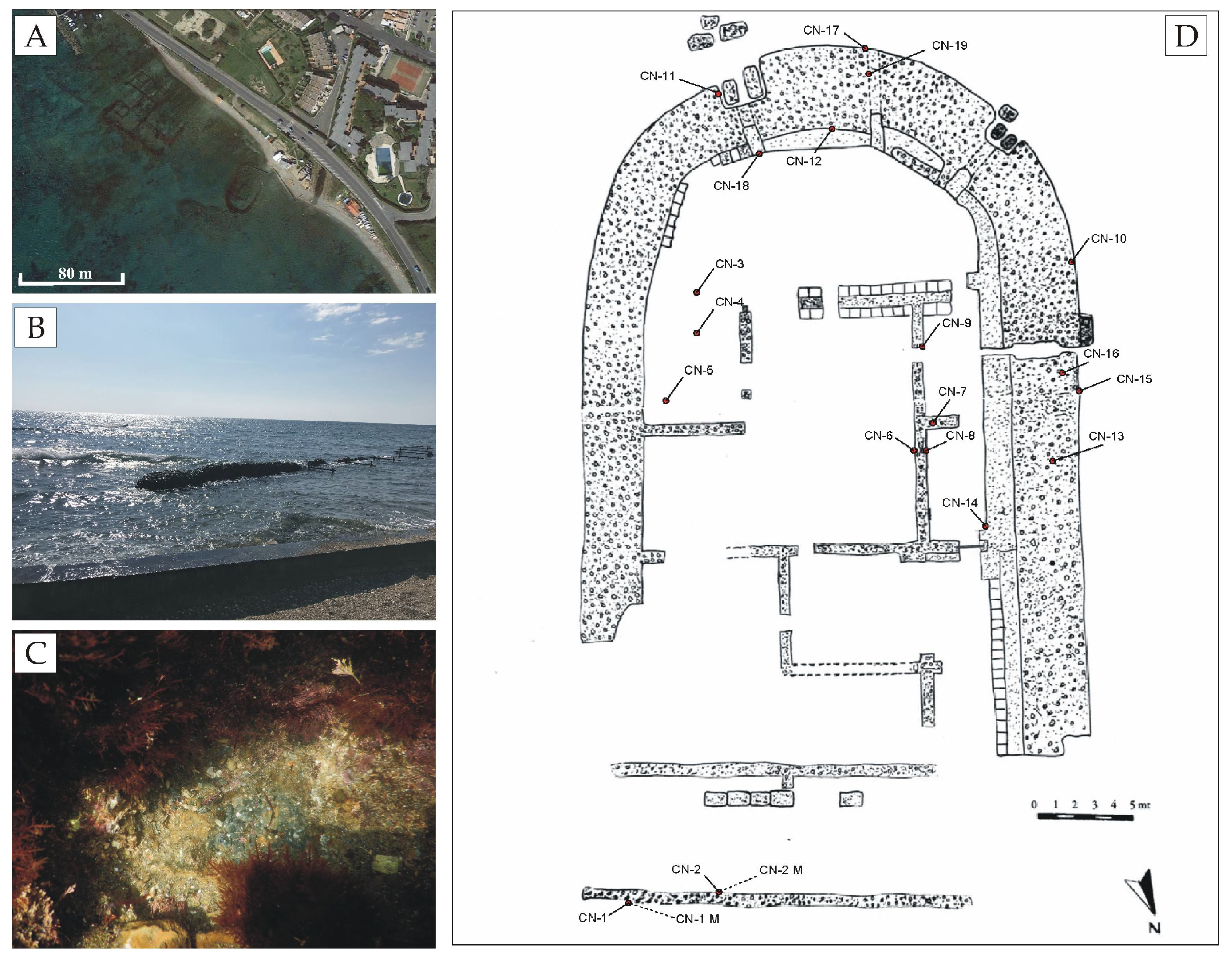
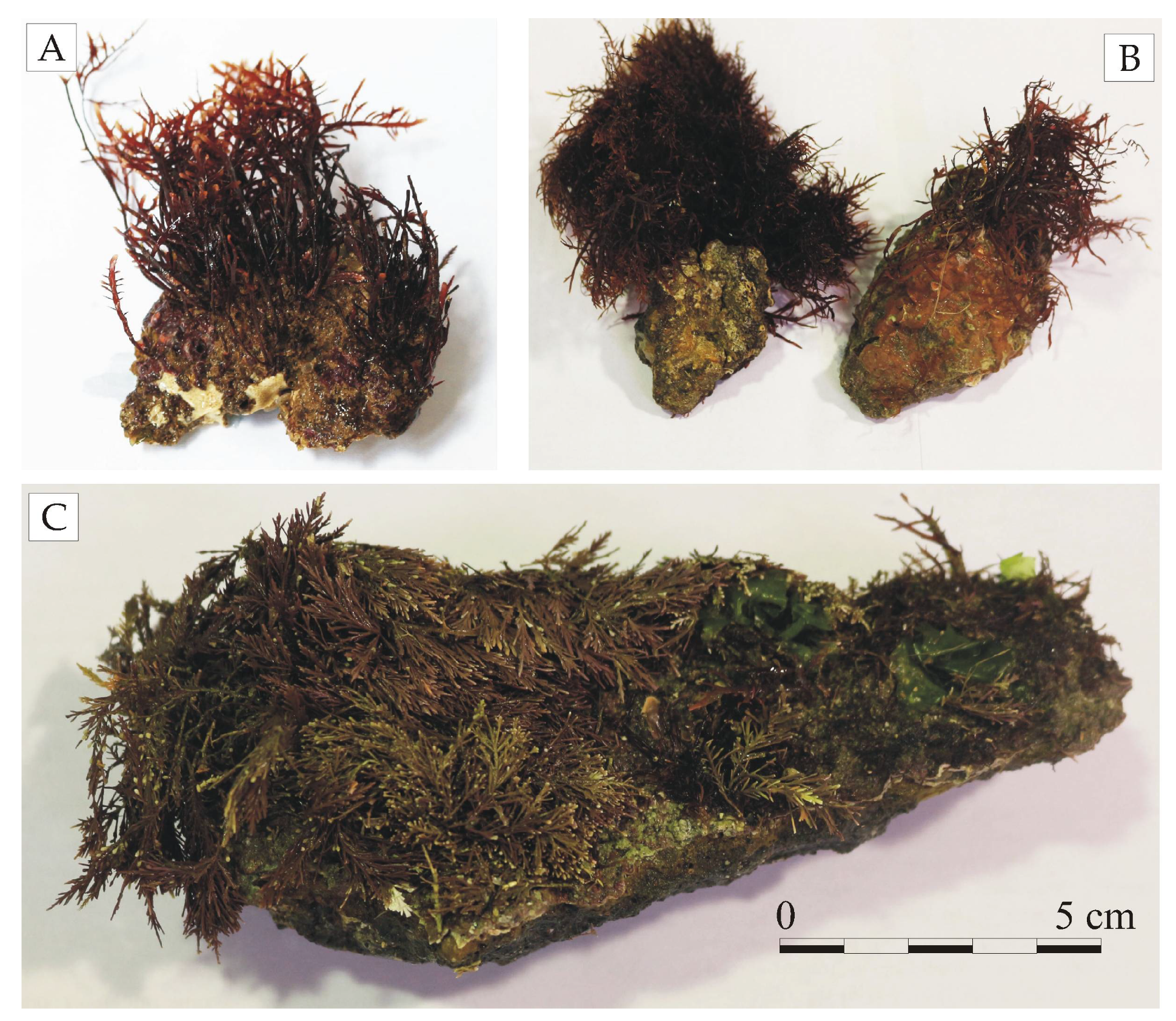
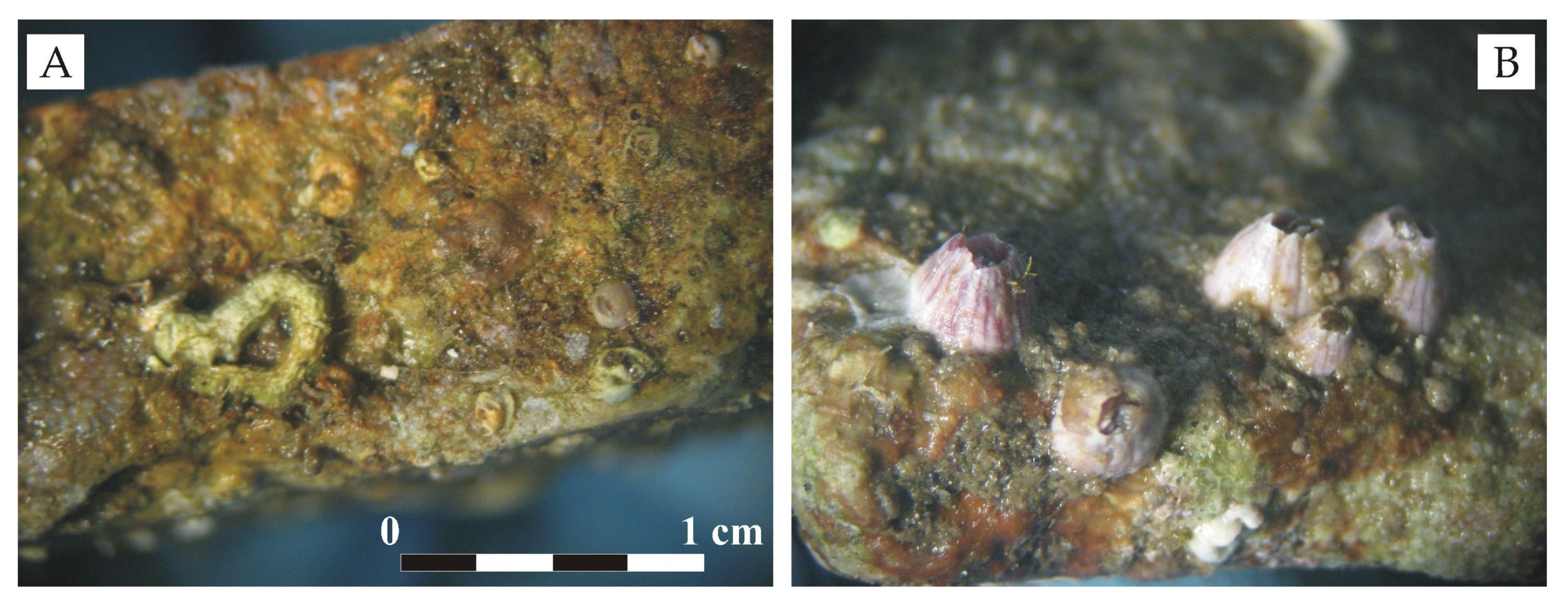
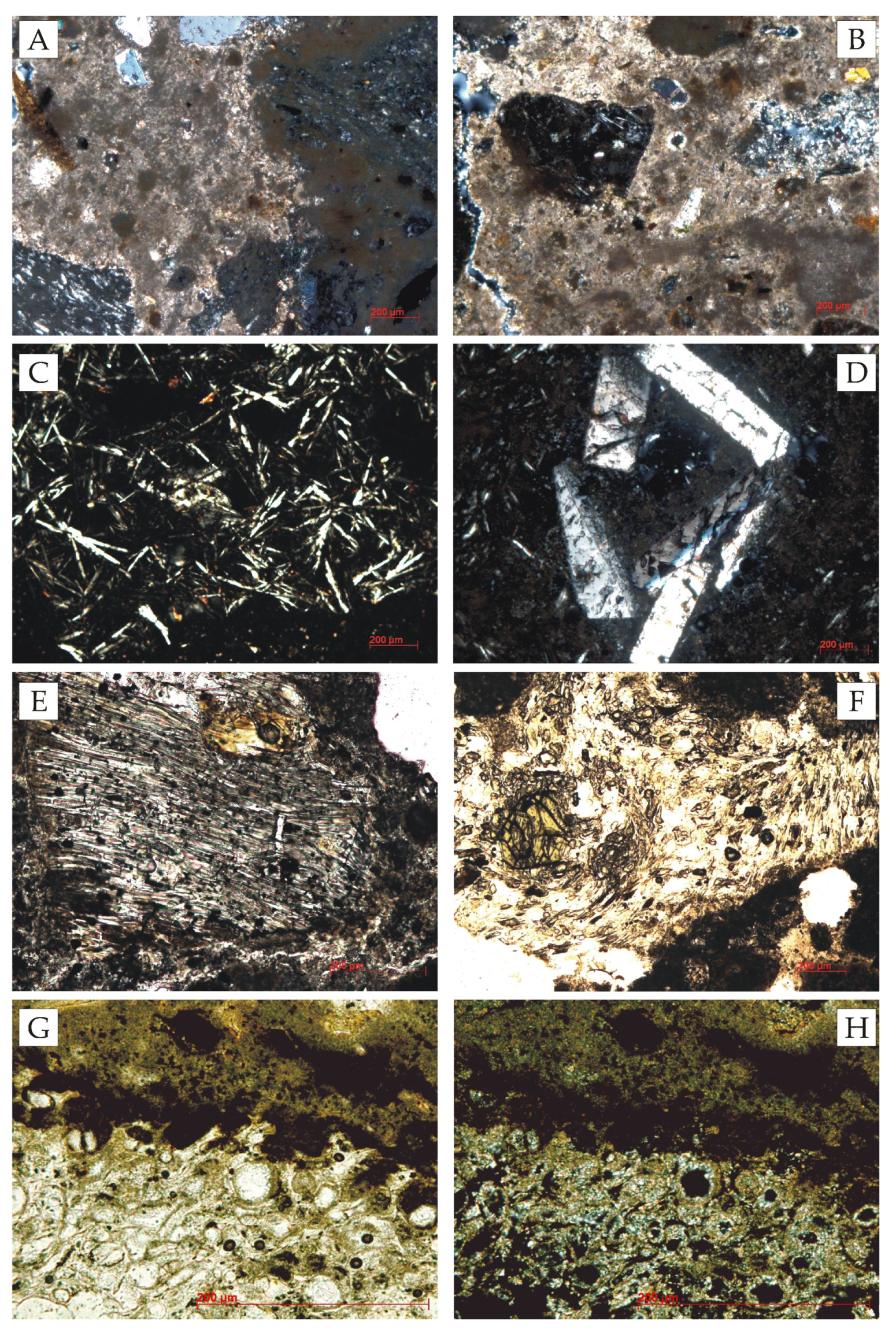
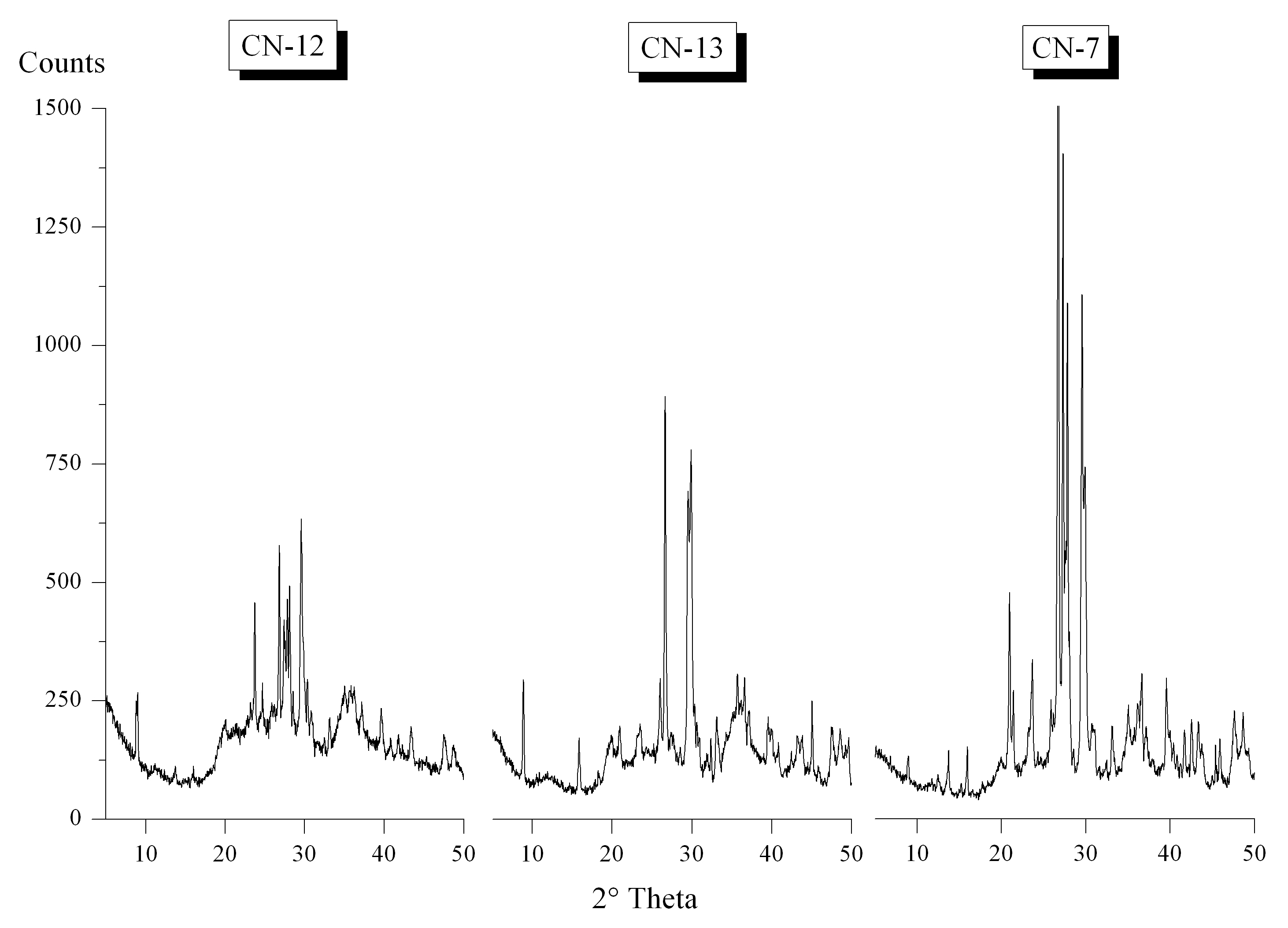
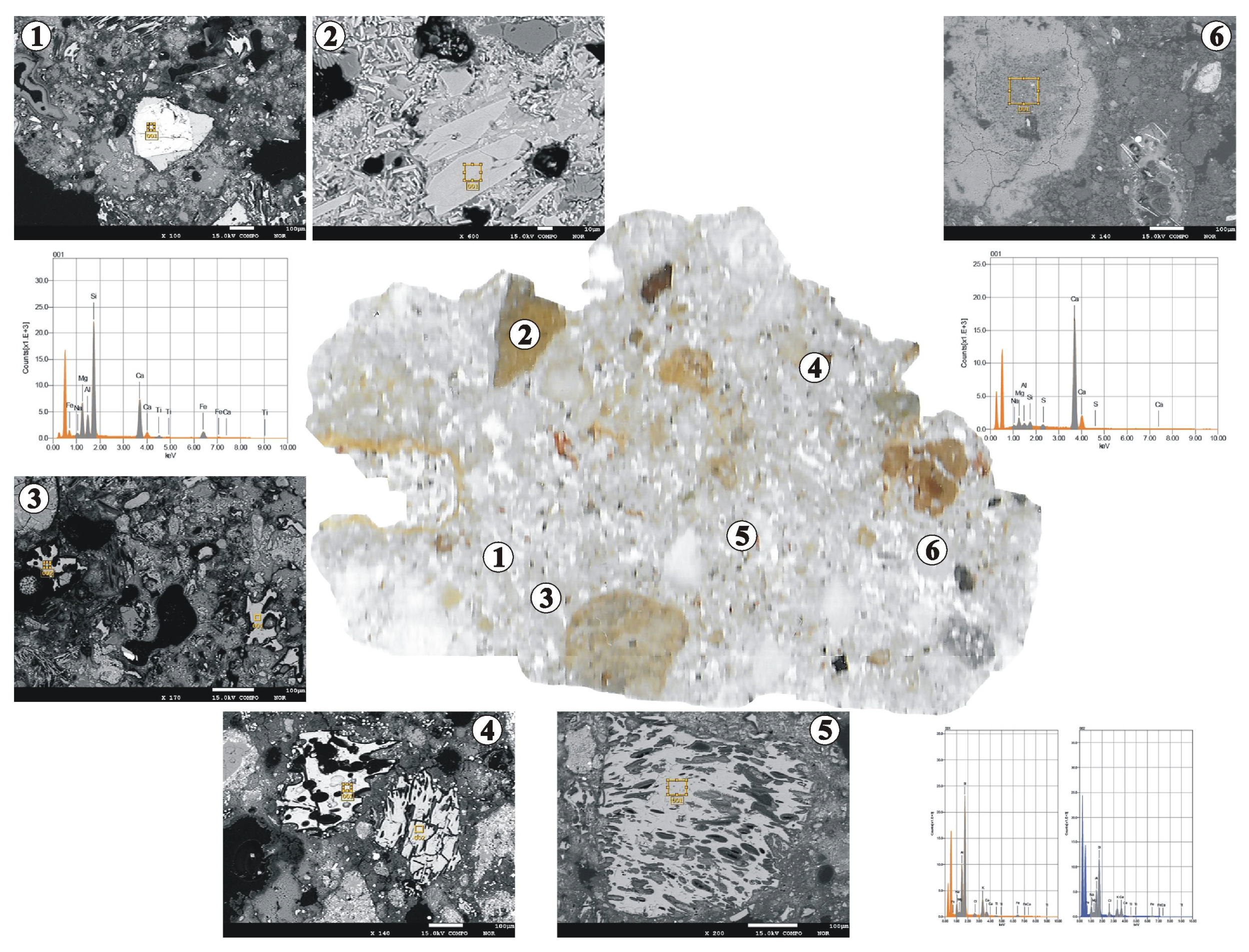
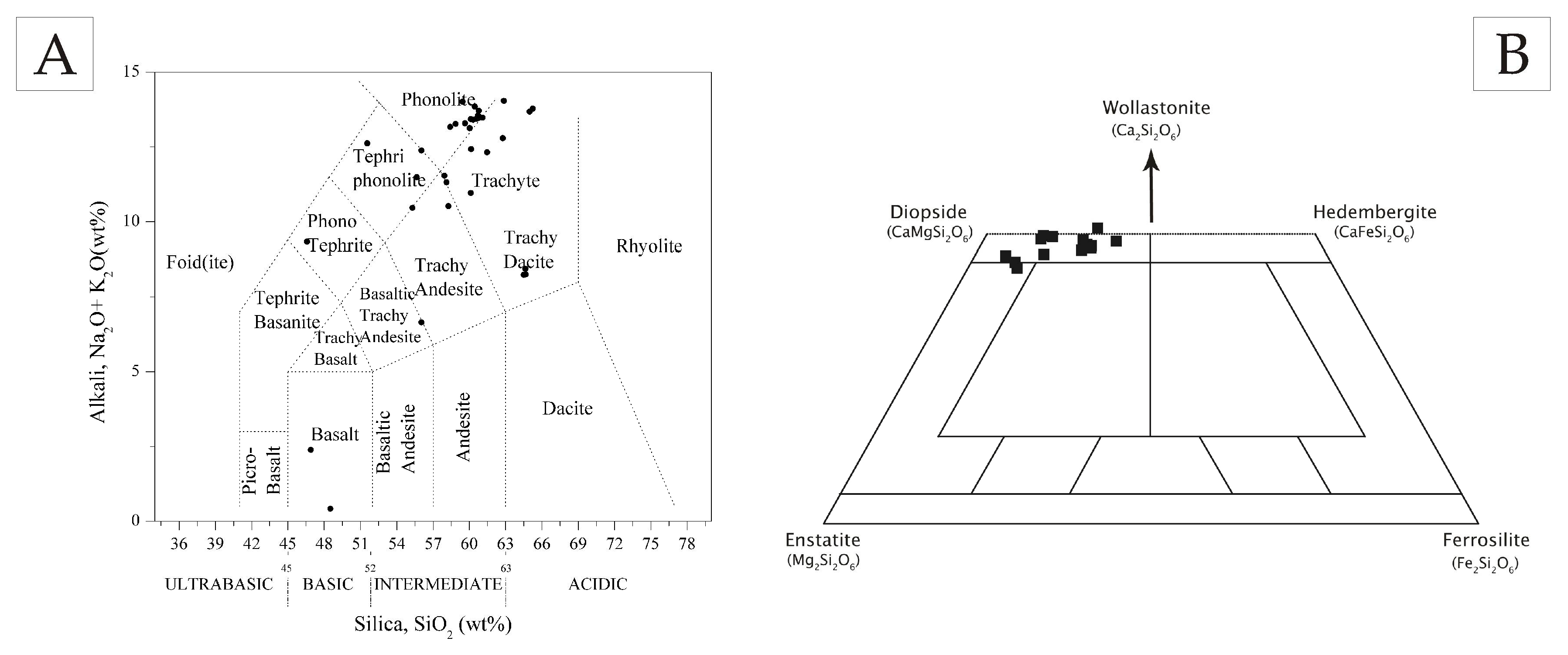
| Sample Code | Description of Superficial Alteration Level | Typology | |
|---|---|---|---|
| 1 | CN-1 | Coherent and compact deposit, mainly whitish in color, alternating with greenish layers. Recognized organisms: barnacles, green and brown algae. Variable thickness ~ 1–3 mm. | coarse aggregate fragment + mortar |
| 2 | CN-1M | Brown–greenish layer, mainly due to algal activity and sediment accumulation. Variable thickness ~ 1–3 mm. | mortar |
| 3 | CN-2 | Brown–greenish layer, mainly due to algal activity and sediment accumulation. Recognized organisms: barnacles and tube-building annelid worms (Serpulidae). Variable thickness ~ 1–5 mm. | mortar |
| 4 | CN-2M | Brown–greenish layer, mainly due to algal activity. Variable thickness ~ 1–2 mm. | mortar |
| 5 | CN-4 | A coherent layer of whitish deposits, mainly due to benthic communities where barnacles and Serpulidae worms prevail. Variable thickness ~ 1–2 mm. | mortar |
| 6 | CN-7 | Thin layer of compact and coherent whitish deposit, alternating with reddish areas. Presence of encrusting algae in addition to brown algae. Variable thickness ~ 1–5 mm. | mortar |
| 7 | CN-8 | Thin brown–greenish deposit layer, mainly due to algal activity and sediment accumulation. Variable thickness ~ 1–2 mm. | mortar |
| 8 | CN-9 | Thin layer of inconsistent whitish deposit alternating with reddish areas. Presence of encrusting algae and sediment accumulation. Variable thickness ~ 1–2 mm. | mortar |
| 9 | CN-10 | Thin layer of compact and coherent whitish deposit, alternating with reddish brown areas. Presence of encrusting algae in addition to green and brown algae. Variable thickness ~ 1–8 mm. | mortar |
| 10 | CN-12 | Layer of whitish deposit, alternating with green and brown areas. Recognized organisms: benthic communities as tube-building annelid worms (Serpulidae) and encrusting algae. There are also green and brown algae. Variable thickness up to several cm. | mortar |
| 11 | CN-13 | Thin layer of reddish-brown deposit. Poor presence of benthic communities in which encrusting algae prevail in addition to green and brown algae. Variable thickness ~ 1–4 mm. | mortar |
| 12 | CN-14 | Compact and coherent layer of whitish color, alternating with red–brown areas. Presence of encrusting algae, red, green and brown algae. Variable thickness up to several cm. | mortar |
| 13 | CN-15 | Compact and coherent layer of whitish color, alternating with red–brown areas. Presence of encrusting algae, red, green and brown algae. Variable thickness up to several cm. | mortar |
| 14 | CN-16 | Slight reddish-brown deposit layer. Poor presence of benthic communities in which green and brown algae prevail. Variable thickness ~ 1–2 mm. | mortar |
| 15 | CN-17 | Compact and coherent deposit layer of brownish-green color, alternating with reddish areas. Presence of encrusting algae, green and brown algae. Variable thickness up to several cm | mortar |
| 16 | CN-18 | Compact and coherent layer of whitish color, alternating with red–brown areas. Presence of encrusting algae and bryozoans. Variable thickness ~ 1–3 mm. | ceramic fragment + mortar |
| 17 | CN-19 | Compact and coherent deposit layer of reddish color attributable almost exclusively to the presence of encrusting algae. Variable thickness up ~ 2–3 mm. | mortar |
| Sample Code | Aggregate | Binder | ||||||
|---|---|---|---|---|---|---|---|---|
| Prevailing Size (mm) | Packing (%) | Mineralogical Phases | Rock Fragments | Bioclasts/Limestone Fragments | Cocciopesto | Texture | Optical Activity | |
| CN-1 | 0.5–1 | 40 | Fs (+ +), Qtz (r) | trachyte (+ +), pumice (+), glassy scoriae (r) | - | - | sporadic lumps | inactive |
| CN-1M | 0.5–1 | 30 | Cpx (+ +); Fs (+), Qtz (r); Op (r); | trachyte (+ +), pumice (+), glassy scoriae (r) | + | - | rare lumps | slightly active |
| CN-2 | 0.5–1.5 | 50 | Cpx (+ +); Fs (+); Qtz (r) | trachyte (+ +), glassy scoriae (r) | - | - | common lumps | inactive |
| CN-2M | 0.5–2 | 20–30 | Cpx (+ +); Fs (+), Qtz (r) | trachyte (+ +), glassy scoriae (r) | - | - | sporadic lumps | slightly active |
| CN-4 | 0.5–1 | 10 | Fs (+ +); Cpx (r), Qtz (r) | pumice (+ +), glassy scoriae (+) | + + | - | common lumps | slightly active |
| CN-7 | 0.5–1.5 | 15 | Fs (+ +); Cpx (+ +); Qtz (r); Bt (r); | trachyte (+ +), pumice (+), glassy scoriae (r) | - | - | common lumps | slightly active |
| CN-8 | 0.5–2 | 10–15 | Fs (+ +); Cpx (+ +); Qtz (r); Bt (r) | pumice (+ +), glassy scoriae (+); trachyte (+) | - | - | sporadic lumps | slightly active |
| CN-9 | 0.5–2 | 30 | Fs (+ +); Cpx (+ +); Qtz (r); Op (r) | pumice (+ +), glassy scoriae (+); trachyte (+) | + | (r) | common lumps | slightly active |
| CN-10 | 0.5–1 | 35 | Fs (+ +); Cpx (+ +); Qtz (r); Pl (r) | glassy scoriae (+); trachyte (+) | - | + | sporadic lumps | slightly active |
| CN-12 | 0.5–1.5 | 30 | Fs (+ +); Cpx (+); Qtz (r) | pumice (+ +), glassy scoriae (+) | - | - | common lumps | inactive |
| CN-13 | 0.5–1.5 | 25 | Fs (+ +); Cpx (+); Qtz (r) | pumice (+), glassy scoriae (+) | - | + | abundant lumps | slightly active |
| CN-14 | 0.5–2 | 40 | Cpx (+ +); Fs (+); Qtz (r); Pl (r); Bt (r); Op (r) | trachyte (+ +), pumice (+), glassy scoriae (+) | - | - | sporadic lumps | inactive |
| CN-15 | 0.5–1.5 | 30 | Qtz (r); Bt (r) | pumice (+ + +), glassy scoriae (+); trachyte (+) | - | + | common lumps | inactive |
| CN-16 | 0.5–1 | 30 | Cpx (+ +); Fs (+); Qtz (r); Pl (r); Bt (r) | trachyte (+ +), pumice (+), glassy scoriae (r) | - | - | sporadic lumps | slightly active |
| CN-17 | 0.5–1 | 10–15 | Fs (+ +); Cpx (+); Op (+); Qtz (r) | trachyte (+ +), pumice (+), glassy scoriae (r) | - | - | rare lumps | inactive |
| CN-18 | 0.2–0.5 | 40 | Fs (+ +); Cpx (+); Qtz (r) | trachyte (+ + +); pumice (+ +), glassy scoriae (+) | - | - | sporadic lumps | inactive |
| CN-19 | 0.5–2 | 40 | Fs (+ +); Cpx (+); Qtz (r) | trachyte (+); pumice (+); glassy scoriae (+) | - | - | sporadic lumps | slightly active |
| Sample Code | CaO | Na2O | MgO | Al2O3 | SiO2 | SO3 | ClO | FeO | SiO2 + Al2O3 + FeO | CaO + MgO | HI | Type |
| CN-1 | 80.71 | 0.97 | 3.10 | 6.78 | 3.00 | 0.72 | 2.17 | 2.54 | 12.32 | 83.82 | 0.15 | WH |
| CN-1M | 84.08 | 0.38 | 4.61 | 1.02 | 7.60 | 0.38 | 0.28 | 1.63 | 10.26 | 88.70 | 0.12 | WH |
| CN-2 | 80.94 | 1.93 | 5.61 | 4.48 | 3.10 | 0.22 | 0.95 | 2.76 | 10.34 | 86.55 | 0.12 | WH |
| CN-2M | 82.52 | 0.75 | 7.71 | 4.33 | 3.92 | 0.24 | 0.52 | - | 8.25 | 90.23 | 0.09 | A |
| CN-4 | 85.25 | 0.72 | 12.03 | - | 0.46 | - | - | 1.54 | 2.00 | 97.28 | 0.02 | A |
| CN-7 | 83.99 | 0.74 | 12.59 | 0.98 | 0.40 | - | - | 1.30 | 2.68 | 96.57 | 0.03 | A |
| CN-8 | 77.63 | 0.58 | 7.97 | 4.48 | 5.92 | - | 0.89 | 2.52 | 12.92 | 85.60 | 0.15 | WH |
| CN-9 | 82.86 | - | 12.06 | 0.58 | 1.49 | 0.42 | - | 2.59 | 4.67 | 94.92 | 0.05 | A |
| CN-10 | 76.14 | 1.22 | 5.85 | 6.40 | 3.72 | 1.06 | 3.14 | 2.45 | 12.58 | 82.00 | 0.15 | WH |
| CN-12 | 72.62 | - | 8.09 | 2.96 | 12.13 | 0.44 | - | 3.75 | 18.85 | 80.71 | 0.23 | MH |
| CN-13 | 69.09 | 0.30 | 12.48 | 5.68 | 8.50 | - | - | 3.96 | 18.13 | 81.57 | 0.22 | MH |
| CN-14 | 74.81 | 0.80 | 9.05 | 2.96 | 8.22 | 0.59 | 0.88 | 2.70 | 13.88 | 83.86 | 0.17 | MH |
| CN-15 | 73.05 | - | 10.69 | 2.86 | 9.27 | 0.41 | 1.24 | 2.48 | 14.61 | 83.74 | 0.17 | MH |
| CN-16 | 82.60 | 0.56 | 4.98 | 1.99 | 4.72 | 0.50 | 0.50 | 4.15 | 10.86 | 87.59 | 0.12 | WH |
| CN-17 | 86.25 | - | 2.92 | 1.72 | 6.29 | - | - | 2.82 | 10.82 | 89.18 | 0.12 | WH |
| CN-18 | 72.81 | 1.07 | 8.01 | 6.42 | 3.59 | 0.35 | 3.62 | 4.12 | 14.14 | 80.82 | 0.17 | WH |
| CN-19 | 74.20 | - | 6.80 | 5.41 | 7.14 | - | 3.50 | 2.95 | 15.51 | 81.00 | 0.19 | MH |
| Lumps | CaO | Na2O | MgO | Al2O3 | SiO2 | SO3 | ClO | FeO | SiO2 + Al2O3 + FeO | CaO + MgO | HI | Type |
| CN-1 | 90.96 | 0.15 | 1.96 | 0.67 | 3.38 | 0.40 | 0.26 | 2.21 | 6.27 | 92.92 | 0.07 | A |
| CN-2 | 88.47 | 0.49 | 3.02 | 1.13 | 1.93 | 0.49 | 0.19 | 4.28 | 7.34 | 91.49 | 0.08 | A |
| CN-2M | 89.70 | 0.71 | 4.11 | - | - | 0.30 | 0.54 | 4.64 | 4.64 | 93.81 | 0.05 | A |
| CN-4 | 93.82 | 1.42 | - | - | 0.70 | 1.24 | - | 2.82 | 3.52 | 93.82 | 0.04 | A |
| CN-7 | 90.59 | 1.74 | 0.49 | 0.54 | 2.95 | 1.17 | - | 2.52 | 6.01 | 91.07 | 0.07 | A |
| CN-8 | 91.81 | 1.57 | 0.48 | 0.53 | 1.82 | 1.20 | - | 2.58 | 4.93 | 92.30 | 0.05 | A |
| CN-9 | 90.19 | 0.44 | 3.66 | 1.11 | 2.35 | 0.65 | - | 1.59 | 5.06 | 93.85 | 0.05 | A |
| CN-10 | 86.25 | - | 2.92 | 1.72 | 6.29 | - | - | 2.82 | 10.82 | 89.18 | 0.12 | WH |
| CN-12 | 84.46 | - | 5.06 | 2.21 | 2.97 | 1.20 | 2.43 | 2.69 | 7.86 | 89.51 | 0.09 | A |
| CN-13 | 80.90 | 0.95 | 7.53 | 3.79 | 3.32 | 0.60 | 1.50 | 1.41 | 8.51 | 88.43 | 0.10 | A |
| CN-15 | 82.58 | 0.39 | 5.05 | 3.32 | 3.08 | 0.57 | 1.45 | 2.56 | 8.96 | 87.63 | 0.10 | WH |
| CN-18 | 81.40 | 0.20 | 3.38 | 4.02 | 7.49 | 0.29 | 1.04 | 2.17 | 13.68 | 84.78 | 0.16 | WH |
| CN-19 | 84.24 | 0.25 | 2.32 | 4.22 | 4.27 | 0.18 | 0.54 | 3.98 | 12.47 | 86.56 | 0.14 | WH |
© 2019 by the authors. Licensee MDPI, Basel, Switzerland. This article is an open access article distributed under the terms and conditions of the Creative Commons Attribution (CC BY) license (http://creativecommons.org/licenses/by/4.0/).
Share and Cite
Randazzo, L.; Ricca, M.; Ruffolo, S.; Aquino, M.; Davidde Petriaggi, B.; Enei, F.; La Russa, M.F. An Integrated Analytical Approach to Define the Compositional and Textural Features of Mortars Used in the Underwater Archaeological Site of Castrum Novum (Santa Marinella, Rome, Italy). Minerals 2019, 9, 268. https://doi.org/10.3390/min9050268
Randazzo L, Ricca M, Ruffolo S, Aquino M, Davidde Petriaggi B, Enei F, La Russa MF. An Integrated Analytical Approach to Define the Compositional and Textural Features of Mortars Used in the Underwater Archaeological Site of Castrum Novum (Santa Marinella, Rome, Italy). Minerals. 2019; 9(5):268. https://doi.org/10.3390/min9050268
Chicago/Turabian StyleRandazzo, Luciana, Michela Ricca, Silvestro Ruffolo, Marco Aquino, Barbara Davidde Petriaggi, Flavio Enei, and Mauro F. La Russa. 2019. "An Integrated Analytical Approach to Define the Compositional and Textural Features of Mortars Used in the Underwater Archaeological Site of Castrum Novum (Santa Marinella, Rome, Italy)" Minerals 9, no. 5: 268. https://doi.org/10.3390/min9050268
APA StyleRandazzo, L., Ricca, M., Ruffolo, S., Aquino, M., Davidde Petriaggi, B., Enei, F., & La Russa, M. F. (2019). An Integrated Analytical Approach to Define the Compositional and Textural Features of Mortars Used in the Underwater Archaeological Site of Castrum Novum (Santa Marinella, Rome, Italy). Minerals, 9(5), 268. https://doi.org/10.3390/min9050268







